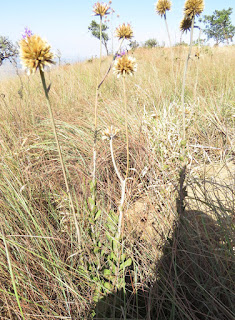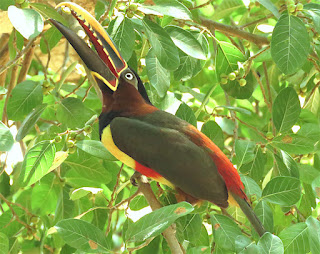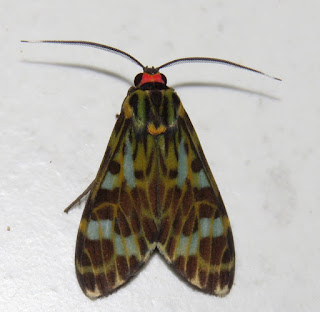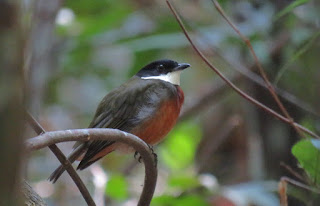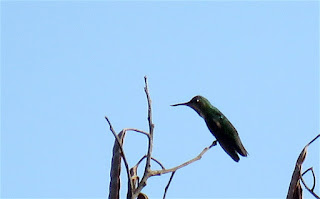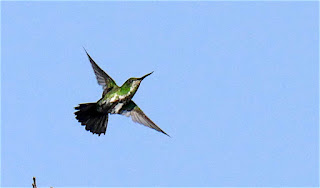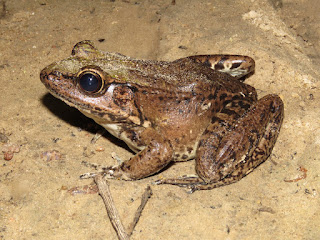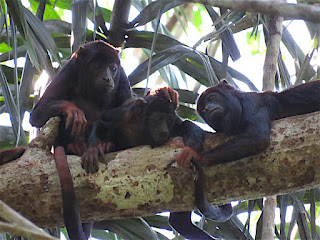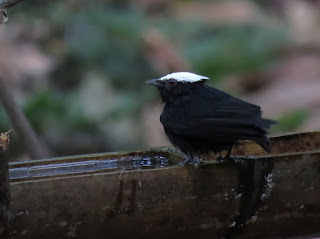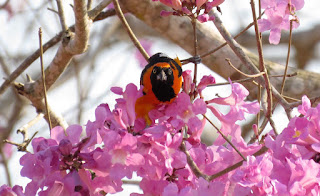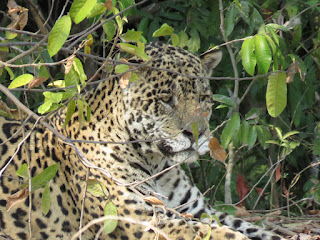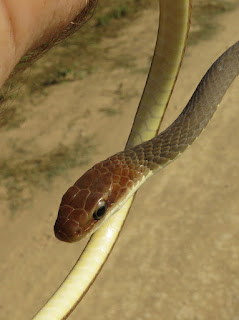My last tour to Brazil’s marvelous state of Mato Grosso finished nearly two weeks ago, so it’s about time I post a quick summary of the natural history highlights. I could also go on about how great the participants were, because most of them really were some of the best ever, but then I’d have to be frank about one who wasn’t (nearly deaf, unaware of how this was a serious disability, and ungrateful for my efforts to assist). But there I go already. So let’s start with my only lifebird of the tour, this fabulous Blue Finch.
This appears to be an immature male, with adult males being completely blue with a stunning yellow bill and females being brown. But I’ll take what I can get. Like my private tour with the Finnish family last month, we started this tour in the Chapada dos Guimarães, and we went to nearly all the same locations. And like then I played the song of Blue Finch here and there in what I thought was appropriate habitat, hoping to stir one, as I have been doing since I first came here ten years ago. But this time we stopped at a spot I had been to a only a couple of times before called Portão do Inferno, or Hell’s Gate, to look for Cliff Flycatcher. It’s a nice vista, but it was utterly void of birds this time, and since it’s right on the main highway the traffic is annoying. Just around the corner from the viewpoint is some habitat that has always looked good, so we walked on another 25 meters, and I played some song. I heard some light chipping, then had poor views of a badly back-lit bird come to the top of a bush and then fly off. Amazingly, it flew only a short ways to our side of the road and into good light, and we all got these great views.
I made some headway in learning some more of the plants here, though later in the year after the first rains start there would be a lot more going on. I was intrigued by this composite, with many small heads bunched up into a ball at the top of a single main stem (the pendcules reduced to a common receptacle), a rather unusual arrangement. That plus the gorgeous purple, long-petaled disk flowers (and no ray flowers), I figured this one was worth figuring out. I got as far as Eremanthus species, with no photos online being very good matches and no photos of E. matogrossensis. So maybe it’s that one. If anyone knows a botanist with a good knowledge of cerrado vegetation, feel free to pass this on and give them my contact information.
We did some birding on foot from our lodge one morning, and at one point I made the classic error of a tour leader who relies too much on his ears and who lacks a perfect visual memory. I had heard some Chestnut-eared Aracaris further down the track we were walking, but they sounded like they were flying away. It’s a common species that I knew we would eventually see, so I only briefly mentioned them and didn’t hurry us along, and while still in the forested stretch we ended up with some amazing views of White-backed Fire-eyes and an Euler’s Flycatcher (I use the indefinite article “an” because Euler was German and is pronounced “oiler”). Unsurprisingly, when we finally emerged from the forest and had some good views of the surrounding trees there weren’t any aracaris around. But then after another 1/2 hour or so of looking at lots of other birds (Sibilant Sirystes, Masked Tityras, and Russet-crowned Crakes among many others) and only another 50 meters along, I spotted the red rump of an aracari sitting quietly in a tree. I called out Chestnut-eared Aracari to my group, quickly got the scope on it, spotted two more in a more distant tree, snapped a quick photo, and ignored them as I surveyed the area for other birds until the aracaris disappeared, and we moved on. Later that night I looked at my photo, a utterly obvious Lettered Aracari.
It’s not rocket science, really. Here’s a real Chestnut-eared Aracari we later saw in the Pantanal. We actually have opportunities to see this species every day on this tour itinerary, though it’s never really abundant.
I had already admitted my growing interest in spiders to the group, so they were helpful to point out this very unusual red spider on our late afternoon outing to Aroe Jari. It was a rather fast runner, but I got it to pause for a few photos. I still don’t know what family it is.
Then came our time at the incomparable Cristalino Jungle Lodge. Most amazing was this Gould's Jewelfront nesting in the very busy staff clearing, with constant foot traffic and noisy construction going on all day long. It had been spotted by my friend Braulio Carlos while he was leading a tour here just a couple weeks earlier, and she was confirmed with chicks during our stay. This species is barely known from the area, and over the past 12 years of visits here I had seen it only twice.
I didn’t focus much on butterflies but did get a shot of this Baeotus aeilus, Amazon Beauty.
There was no moth sheet; just the lights along the walkway, which had few goodies. This attractive Eucereon sp. tiger moth was actually in the leaders’ scheduling office one evening.
Sunbitterns performed well for us, and while I’ve done better, I always rejoice in getting any shot of one in flight.
This is probably the same Flame-crowned Manakin that I saw last month along the Manakin Trail, though this time we did not see a Black Manakin here.
No photos to show, but two of the most interesting sightings of the tour came from the drying up pond at the end of the Manakin Trail. First was the continuing Rufous-tailed Attila from a month ago, which appears to be the first wintering record from the area (others are assumed to have been spring migrants heading southeast). It hadn’t been seen by any others since I had it here with the Finns, but this time we only glimpsed it and heard it call a few times. I got a recording which I appended to my eBird submission. I don’t know how to embed a play from the Macaulay Library website, so here’s a link to my recording: http://macaulaylibrary.org/asset/32551731
But even more interesting was a Tolmomyias flycatcher that I tentatively identified at the time as a Gray-crowned Flycatcher, noting the river edge-like habitat and the two-syllabled upslurred notes in part of the song. I had actually spotted a nest of a Tolmomyias flycatcher overhanging one end of the pond clearing first, so I wasn’t that surprised to finally see one. But the burry introductory notes were kind of strange, and fortunately I recorded it and later realized that this sounded quite unlike the rather invariable and higher pitched Gray-crowned Flycatcher. In fact, it matched the song of a pair of subspecies of Yellow-margined Flycatcher that had never been recorded before at Cristalino, Tolmomyias assimilis assimilis/calamae. What makes it most interesting is that there is a very common resident subspecies of Yellow-margined Flycatcher (T. a. paraensis) at Cristalino which occurs in the canopy of tall forest and has a utterly different voice, and here we have the two living sympatrically in different habitats – about as good of evidence of species status as you need.
Here’s my recording of this bird:
Here’s a recording of a bird identified as T. a. calamae from much farther southwest that sounds just like my bird.
Here’s a recording of a bird typical of Cristalino, T. a. paraensis.
Another fun find at Cristalino was the continuing female Fiery-tailed Awlbill on the serra, which like the Rufous-tailed Attila hadn’t been seen since my last visit here exactly a month ago. This time we got photos. Here’s mine.
And here’s the amazing shot from one participant, Bob Pease.
One final fabulous bird sighting at Cristalino was this Gray-breasted Crake, a first for the lodge grounds itself, and a lifer for Jorge, who’s been here for 20 years. It’s a common bird in dense grassy areas in the larger region, dry and wet, but even where abundant is very hard to see, preferring to stick to the impenetrable vegetation. In the small patch of water-hyacinths by the boat dock on the narrow Cristalino River, this bird was ridiculously out-of-place and unbelievably tame. It was completely exposed for at least 20 minutes, walking around within just a few feet of over a dozen gawking birders and photographers. This is perhaps the worst photo anyone obtained.
But as always, there’s more than just birds at Cristalino. I was on my own by the river rocks one night when I watched this Hydrodynastes gigas, False Water Cobra, swim around and disappear into the rocks. During the 20 minutes I was here it never surfaced for air.
This Lithobates palmipes, Amazon River Frog was on the sand by the boats.
I was on my own on the trail late at night when I heard the typical noise of an armadillo rooting around in the leaf litter. But this one was much larger than the usual nine-banded. It was almost as large as a Giant Armadillo, but the tall, close-set ears and long nose showed it was Dasypus kappleri, Great Long-nosed Armadillo, perhaps the first documented record for Cristalino.
One afternoon this family of Alouatta discolor, Spix's Red-handed Howlers was lounging near the boat dock.
This Tamandua tetradactyla, Southern Tamandua was right above the trail one afternoon.
On our last morning, my friend Jorge Lopes showed us this bat on the ground by the trail to Tower 1. I eventually deduced that it was probably Nyctinomops macrotis, Big Free-tailed Bat, and was able to confirm that with my mammalogist friend Fiona Reid.
My best bird photos came from two watering holes – the drying up natural pond called the Lagoinha well upriver, and the other a plastic bird bath and two bamboo troughs that the local guides fill with water daily just downstream from the lodge. Both are just one or two hundred meters walk from the river’s edge. This Band-tailed Antbird was one of several at the first location.
This Green-and-rufous Kingfisher was also at the first. I had to mount my camera on my tripod and use a 1/5 second exposure in the dark forest understory. But the bird sat still for about 15 minutes at close range before it plunged after a fish or tadpole. This perspective surprised me by showing how broad its bill is.
These latter were at the bird bath called Franciso’s Poçinha. Snow-capped Manakin
White-crowned Manakin female
White-crowned Manakin male
White-winged Shrike-Tanager
We had four excellent full days in the Pantanal. This Diaethria clymena, Widespread Eighty-eight was on the road at Porto Jofre.
This is a typical sight of Great Egrets and Snowy Egrets at many of the 120+ bridges we cross on the way to Porto Jofre.
I usually schedule a birding excursion during the late afternoon hours when bird activity picks up, but after the long drive we just had some time off at our hotel in Porto Jofre, and this is apparently when the several pairs of Hyacinth Macaws become social, feeding on the many palms around the buildings and cavorting on the lawn.
This is an Orange-backed Troupial in a clashing but still striking backdrop of a blooming piuva tree, Handroanthus heptaphyllus or H. impetiginosus (family Bignoniaceae).
This was my first Least Bittern in Brazil, and I was not prepared for how different it sounded and looked from our North American birds. It’s the subspecies Ixobrychus exilis erythromelas, and with its distinctly disjunct distribution (and no chance for any intergradation), I’d say that splitting it as a separate species is simply a clerical exercise. You just have to admit that we inherited a defunct master list of the birds of the world; it shouldn’t take the lethargic movements of a committee to fix it.
This American Pygmy Kingfisher was at the same bridge as the bittern above. Without the benefit of a size perspective it’s surprisingly similar to the Green-and-rufous Kingfisher, though the bill does appear to be narrower.
Of course, we saw jaguars. We had reserved four boat trips (morning and afternoon on each of two days), but having seen three jaguars on our first morning trip up the Cuiabá River, thanks to the other 20 boats looking along several miles of river and communicating by radio, we stopped responding to the calls on our subsequent trips. I’m not sure if I should be surprised that I had never seen any of these three jaguars – the 17th through 19th different individuals I’ve seen along just a few miles of river here.
This old, scarred male with a very broad head was apparently new to the study area this year, and my contact, Paul Donahue, didn’t have a name for it. We came across him our first morning and again the next day, 5 kilometers farther upriver.
These two jaguars were together, at times playful, and at times just relaxing and possibly hunting. The first and larger of the two is known as Susanna. One would assume that the smaller one, unknown before this year, would be her daughter, but it’s an adult, and Susanna wasn’t seen with a cub last year. Maybe she kept her hidden.
On our last day, August 18, there was a slight change in the weather: it was warmer and more humid in the morning, clouds began appearing mid-day, and we actually drove through a brief rain shower. The rainy season doesn’t really begin until after mid-October, so this is early for the first break in the extended dry season, no matter how feeble. But it certainly woke up the snakes, as we had three species today, a spectacular grande finale to the tour. The first was this Chironius quadricarinatus, with Central Sipo the only English name I could find.
Then our driver José spotted this Eunectes notaeus, Yellow Anaconda, about to cross the road, and before we all knew it, he had jumped out of the vehicle and had grabbed it, keeping it from disappearing in the roadside shrubbery. I had thought this species would be “bitey,” but I was wrong. I helped José free the snake from the branches, and four of us posed for photos with this calm and gorgeous animal.
Finally, just before we turned into the drive for our last night's lodge, this Drymarchon corais, the melanistic populations in the US known as Indigo Snake, graced the road then swiftly disappeared when we approached. It was too fast for my camera, so this shot is courtesy of participant John Collen.

